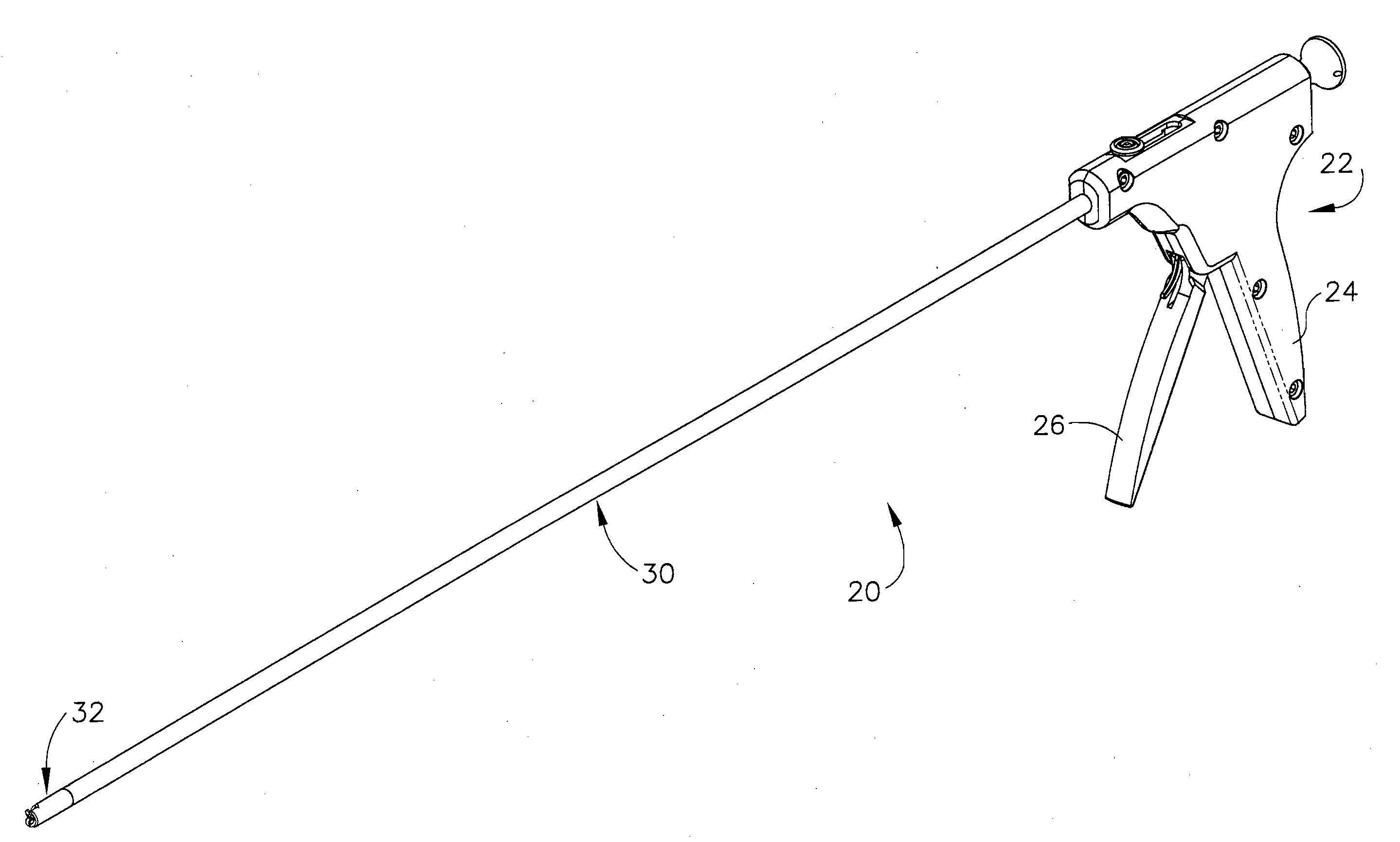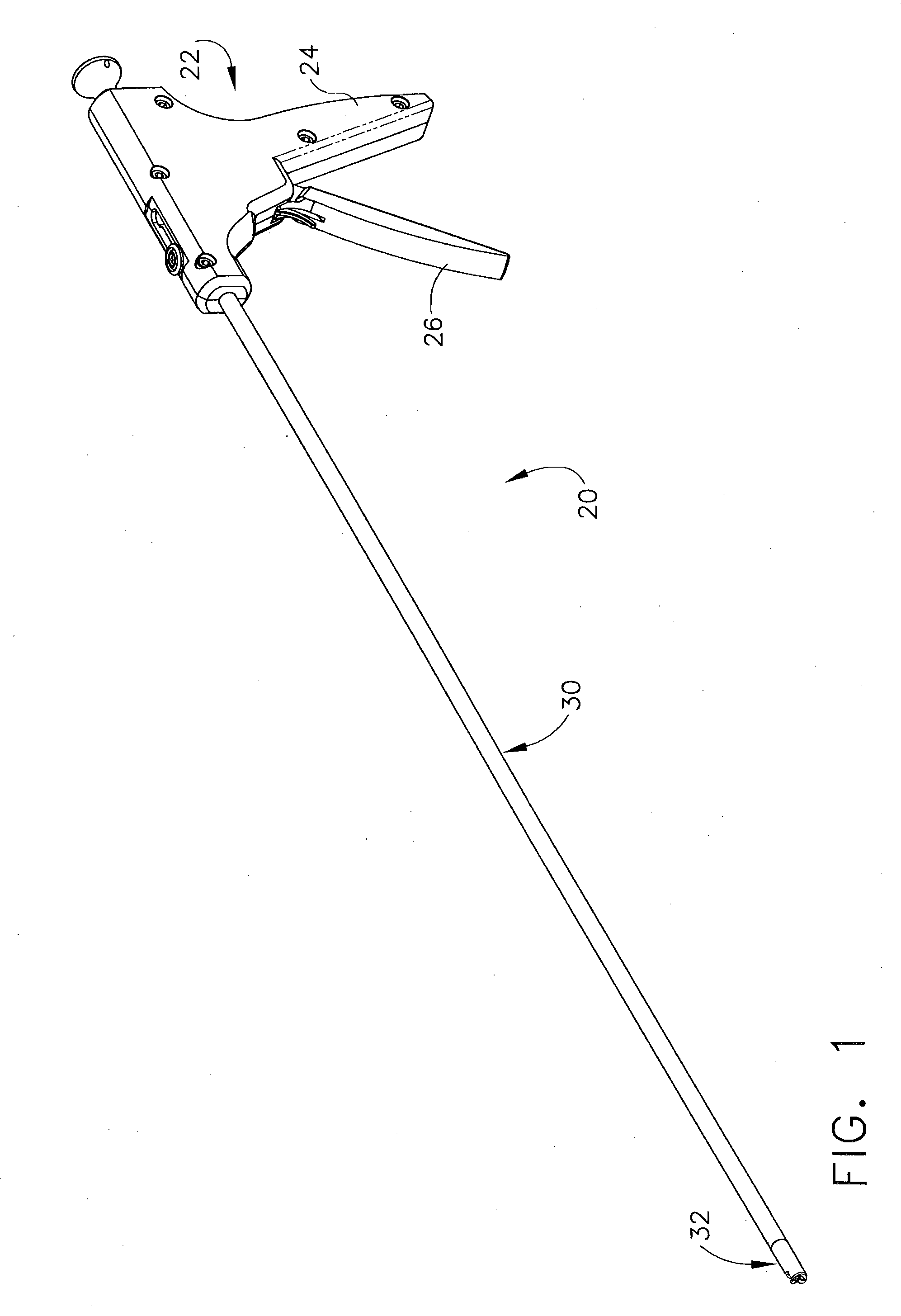Reloadable laparoscopic fastener deploying device for use in a gastric volume reduction procedure
a gastric volume and gastric bypass technology, applied in the field of gastric bypass surgery, can solve the problems of obesity affecting the personal contributing significantly to morbidity and mortality, and affecting the quality of life of individuals, and the estimated cost of obesity and its co-morbidities is over $100 billion dollars annually in direct and indirect health care costs
- Summary
- Abstract
- Description
- Claims
- Application Information
AI Technical Summary
Benefits of technology
Problems solved by technology
Method used
Image
Examples
first embodiment
[0077]Fastener deploying device 20 is designed for use with a replaceable fastener cartridge. As shown in FIG. 1, the fastener cartridge 32 is releasably attachable to the distal end of housing 30. Cartridge 32 is sized and shaped for passage through a 3-5 mm trocar when attached to the deploying device. Coupling members are located on the distal end of housing 30 and the proximal end of cartridge 32 for releasably attaching the cartridge to the deploying device. The cartridge coupling members allow for a rapid and secure removal and replacement of a cartridge. FIGS. 2 and 3 are simplified views of cartridge 32 and housing 30, depicting a first embodiment for coupling a cartridge to the distal end of the housing. In this embodiment, the coupling members include a pair of circumferentially offset, longitudinally extending open channels on the body of the cartridge. A first one of the open channels 34 extends from the proximal end of the cartridge distally to a point just beyond the p...
second embodiment
[0106]After the second T-Tag anchor is deployed, the device can be reset to place push rod 140 back inside of housing 30. In the second embodiment described herein, the actuator further includes a secondary trigger 240. Secondary trigger 240 is located on the distal side of handle 22, between the primary trigger 26 and housing 30, and within easy reach by the same hand that grips the primary trigger. One of the functions of secondary trigger 240 is to control the resetting of the device. As shown in FIGS. 41-43, secondary trigger 240 includes a cam surface 274 at the fixed end of the trigger. Cam surface 274 rests against one end of a release post 276, which is contained within the primary trigger 26. With trigger 26 held in place by latching mechanism 280, the opposite end of release post 276 is in contact with the proximal end of drive pawl 160. With the primary trigger 26 held in place by the latching mechanism, the deploying device is reset by squeezing the secondary trigger 240...
fourth embodiment
[0117]FIG. 52 shows a fourth embodiment for the present invention, in which the deploying device is modified to include a protective outer sheath 290 that extends distally over the length of the cartridge. Outer sheath 290 extends proximally over housing 30 and is attached at a proximal end to button 132. In this embodiment, button 132 is attached to outer sheath 290 rather than housing 30, in order to retract and advance the outer sheath relative to the cartridge. Housing 30 is affixed in place within handle 22 by pins 300 located adjacent the proximal housing end, as shown in FIG. 53. A cutting means such as a V-notch 294 can be provided in the distal end of outer sheath 290 for severing suture following cinching. When button 132 is in a distal position, such as shown in FIG. 53, needle 52 is concealed within outer sheath 290. As button 132 is depressed to slide post 130 along track 134, the outer sheath 290 is retracted along the cartridge to expose needle 52 from the distal end ...
PUM
 Login to View More
Login to View More Abstract
Description
Claims
Application Information
 Login to View More
Login to View More - R&D
- Intellectual Property
- Life Sciences
- Materials
- Tech Scout
- Unparalleled Data Quality
- Higher Quality Content
- 60% Fewer Hallucinations
Browse by: Latest US Patents, China's latest patents, Technical Efficacy Thesaurus, Application Domain, Technology Topic, Popular Technical Reports.
© 2025 PatSnap. All rights reserved.Legal|Privacy policy|Modern Slavery Act Transparency Statement|Sitemap|About US| Contact US: help@patsnap.com



